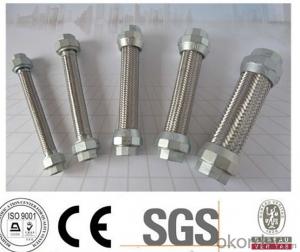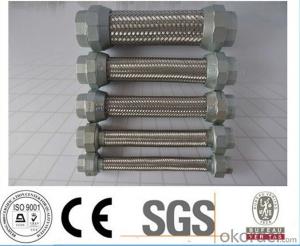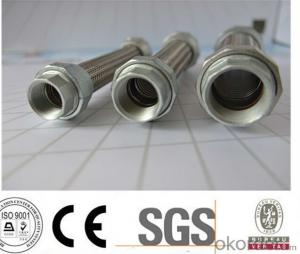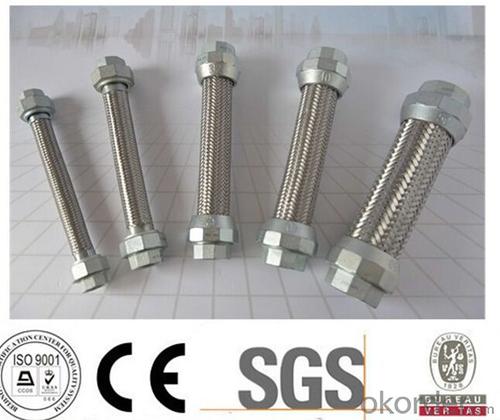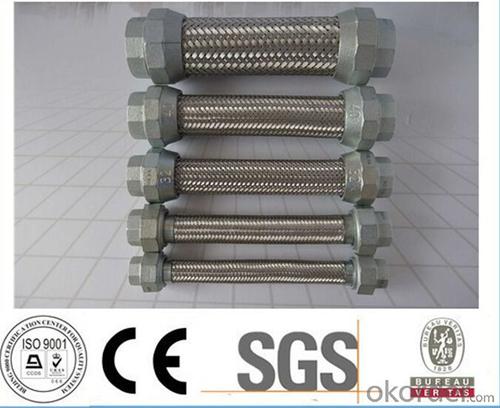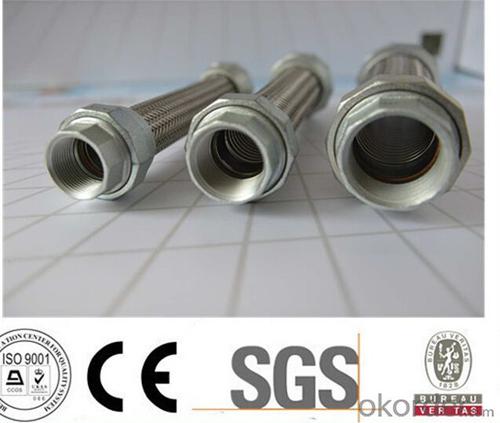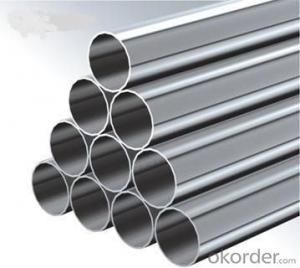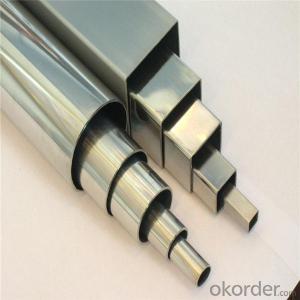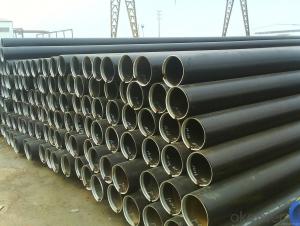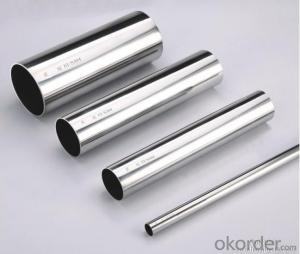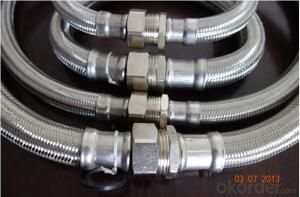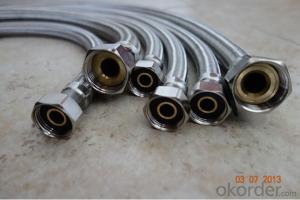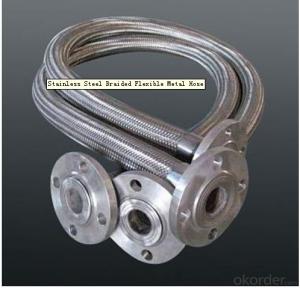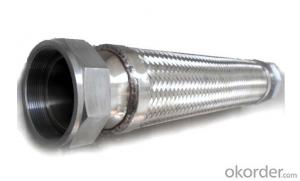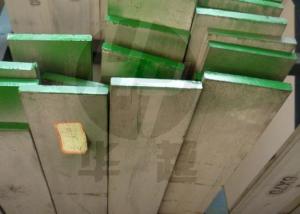Stainless Steel Braid Hose with Inside Fittings
- Loading Port:
- Tianjin
- Payment Terms:
- TT OR LC
- Min Order Qty:
- 1000 pc
- Supply Capability:
- 100000 pc/month
OKorder Service Pledge
OKorder Financial Service
You Might Also Like
Specification
Stainless Steel Braid Hose with Inside Fittings
Applications of Stainless Steel Braid Hose with Inside Fittings:
--Refueling system
--Chemical and pharmaceutical industry
--Industrial hydraulic systems
--Air conditioners in industrial and construction –site vehicles
--Food and beverage industry
--Special and standard industrial applications
--Water and cleaning management
Features of Stainless Steel Braid Hose with Inside Fittings:
1. )O. D.: 13-18MM 0.2-3M long
2. )Nut.: Nickel/Chrome Plated Brass (Zinc / Iron / Aluminum is available)
3. )Size Of Nut.: Female&Male 1/2''; 3/4''; 3/8''; 7/8''; 5/16'', and M10...
4. )Insert.: Brass (Zinc / Aluminum / Plastic is available)
5. )Inner tube.: Rubber/ EPDM/PVC
6. )Covered Material: Stainless Steel 201, 301, 304 /Aluminium Wire
7. )Working Pressure: 5Kg-15Kg
8. )Temperature: 0-92° C
9. )Quality Assurance: 3 years
RemarkAPPLICATION: HOUSEEHOLD WARE, BATHROOM WARE, SHOWER HOSE
PAYMENT: T/T, L/C
DELIVERY TIME: 20DAYS OR 30DAYS AFTER RECEIVED 30% DEPOSITS
MOQ: 5000PCS
ODM&OEM IS ACCEPTABLE
PackageInner: PP bag /Blister packing Outer: Carton box
Specifications of Stainless Steel Braid Hose with Inside Fittings:
NO | I.D | Refer to O.D | Working pressure | Burst pressure | approximate Weight | |||||
(inch) | (mm) | (inch) | (mm) | MPa | Psi | MPa | Psi | kg/m | lbs/ft | |
1 | 1/8 | 3.2±0.2 | 0.35 | 9±0.3 | 2.06 | 300 | 8.27 | 1200 | 0.078 | 0.12 |
2 | 5/32 | 4±0.2 | 0.4 | 10±0.3 | 2.06 | 300 | 8.27 | 1200 | 0.092 | 0.14 |
3 | 3/16 | 4.8±0.2 | 0.43 | 11±0.3 | 2.06 | 300 | 8.27 | 1200 | 0.108 | 0.16 |
4 | 1/4 | 6.3±0.3 | 0.5 | 12.7±0.3 | 2.06 | 300 | 8.27 | 1200 | 0.134 | 0.2 |
5 | 5/16 | 8.0±0.3 | 0.56 | 14±0.3 | 2.06 | 300 | 8.27 | 1200 | 0.147 | 0.22 |
6 | 3/8 | 9.5±0.3 | 0.63 | 16±0.4 | 2.06 | 300 | 8.27 | 1200 | 0.182 | 0.27 |
7 | 15/32 | 12±0.3 | 0.75 | 19±0.5 | 2.06 | 300 | 8.27 | 1200 | 0.238 | 0.35 |
8 | 1/2 | 12.7±0.4 | 0.78 | 20±0.5 | 2.06 | 300 | 8.27 | 1200 | 0.262 | 0.39 |
9 | 5/8 | 16±0.4 | 0.94 | 24±0.5 | 1.03 | 150 | 4.12 | 600 | 0.351 | 0.52 |
10 | 3/4 | 19±0.4 | 1.13 | 28.8±0.5 | 1.03 | 150 | 4.12 | 600 | 0.515 | 0.77 |
11 | 1 | 25.4±0.5 | 1.38 | 35±0.6 | 1.03 | 150 | 4.12 | 600 | 0.637 | 0.95 |
Images of Stainless Steel Braid Hose with Inside Fittings:
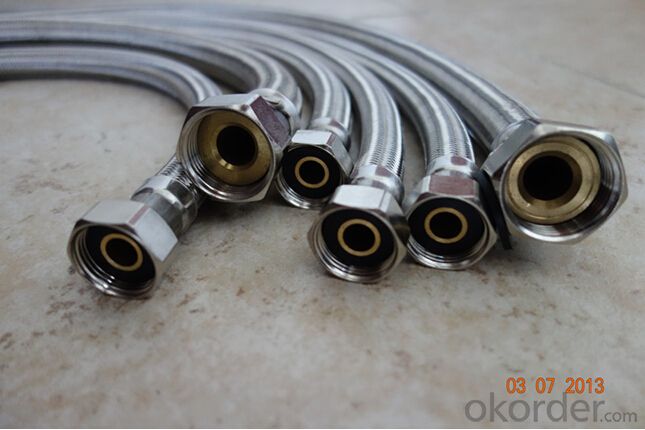
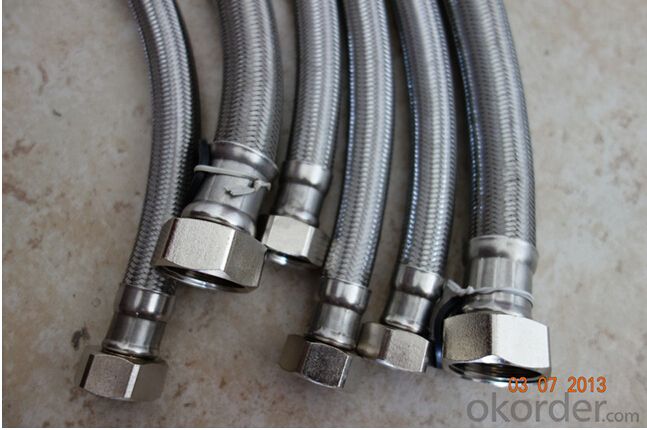
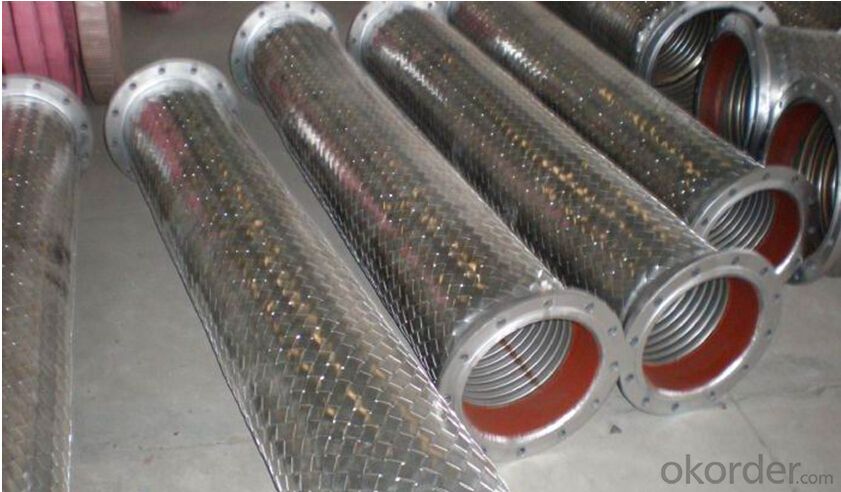
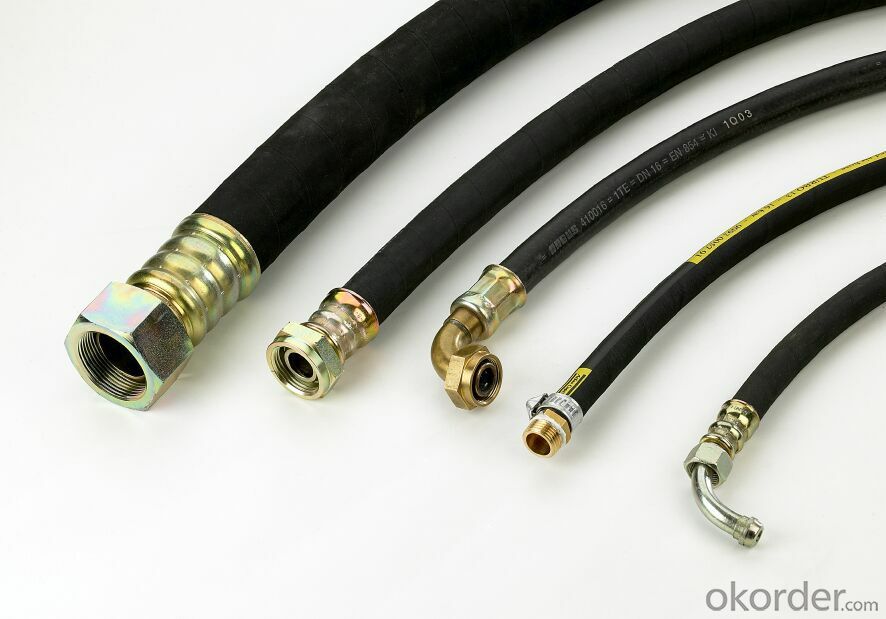
Package of Stainless Steel Braid Hose with Inside Fittings:
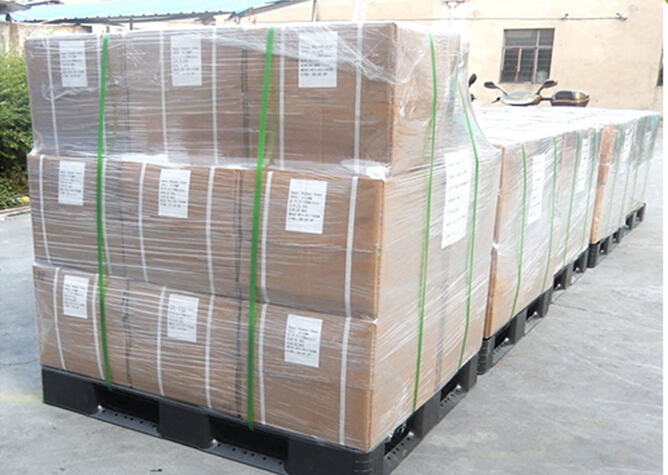

FAQ of Stainless Steel Braid Hose with Inside Fittings:
Who we are:
Answer: We CNBM is a Chinese state-owned enterprise ranked 267th among the Global Fortune 500, as the largest building materials company,we have over 300 affiliated companies,and so many production lines and branch office distribute in China.
2. About our quality:
Answer: Every product needs to be quality proved before shipping.
3. About our service:
Answer: We could gurantte that we can reply you in 2 working hours.
- Q: What are the common types of fittings used with stainless steel pipes?
- Stainless steel pipes are commonly paired with various types of fittings. Some fittings that are frequently utilized include: 1. Stainless Steel Threaded Fittings: These fittings possess threaded ends, enabling effortless connection to pipes or other fittings. They are typically employed in low-pressure scenarios and can be easily installed or removed using a wrench. 2. Stainless Steel Butt-Weld Fittings: Butt-weld fittings are utilized to seamlessly join stainless steel pipes. These fittings are directly welded to the pipe, resulting in a robust and leak-free connection. Butt-weld fittings find common use in high-pressure or high-temperature applications. 3. Stainless Steel Flanges: Flanges are employed to bolt pipes or fittings together, ensuring a secure and inflexible connection. They can be conveniently disassembled when necessary. Various types of flanges are available, including slip-on, weld neck, socket weld, and blind flanges. 4. Stainless Steel Compression Fittings: Compression fittings create a tight seal between pipes by compressing a ferrule against the pipe. They are commonly found in plumbing systems and provide a trustworthy and leak-free connection. 5. Stainless Steel Camlock Fittings: Camlock fittings are quick-connect fittings frequently used in industrial settings. They consist of a male and female end that can be effortlessly joined by simply pushing them together and locking them in place. Camlock fittings are well-regarded for their user-friendly nature and versatility. These are just a few examples of the fittings commonly employed with stainless steel pipes. The choice of fitting depends on the specific application, pressure, temperature, and other relevant factors. It is crucial to select the appropriate fitting to ensure a secure and dependable connection.
- Q: Are stainless steel pipes more expensive than other types of pipes?
- Generally speaking, stainless steel pipes tend to be pricier compared to other pipe variants. This can be attributed primarily to the expensive raw materials utilized in their production, along with the intricate manufacturing procedures involved. In addition, stainless steel pipes boast numerous advantages over alternative options, including exceptional resistance to corrosion, heightened durability, and the capacity to withstand extreme temperatures. These factors collectively contribute to their elevated price range. Nevertheless, for many applications, the long-term benefits and superior performance of stainless steel pipes often outweigh the additional cost, justifying their investment.
- Q: How long do stainless steel pipes last?
- Stainless steel pipes have an impressive lifespan and can last for several decades, depending on various factors such as the quality of the steel, installation techniques, and maintenance practices. In general, with proper care and maintenance, stainless steel pipes can last 50 years or more.
- Q: What is the difference between ferritic and austenitic stainless steel pipes?
- The main difference between ferritic and austenitic stainless steel pipes lies in their microstructure and composition. Ferritic stainless steel pipes are made up of a ferritic crystal structure, which is characterized by a high chromium content and low carbon content. This makes them highly resistant to corrosion and oxidation, but they have lower strength and are not suitable for high-temperature applications. On the other hand, austenitic stainless steel pipes have an austenitic crystal structure, consisting of high amounts of nickel and chromium, with a relatively low carbon content. This composition gives them excellent corrosion resistance and high strength, making them suitable for a wide range of applications, including high-temperature environments. They also exhibit good ductility and can be easily welded and formed. Overall, ferritic stainless steel pipes are preferred in low-temperature and non-corrosive environments, while austenitic stainless steel pipes are commonly used in high-temperature and corrosive applications.
- Q: How do you calculate the wall thickness for stainless steel pipes under external pressure?
- To calculate the wall thickness for stainless steel pipes under external pressure, you need to consider various factors such as the material properties, design codes, and the applied external pressure. Here is a general approach to calculating the wall thickness: 1. Determine the design pressure: The first step is to identify the external pressure that the stainless steel pipe will be subjected to. This pressure can be due to factors like fluid flow, environmental conditions, or operational requirements. 2. Determine the material properties: Stainless steel pipes have different grades, each with its own mechanical properties. Consult the material specifications to obtain the values for the yield strength (Sy) and ultimate tensile strength (Su) of the specific stainless steel grade you are working with. 3. Determine the allowable stress: The allowable stress (Sa) is the maximum stress that the material can sustain under the given conditions. It is usually provided by design codes or standards such as ASME B31.3 for process piping or ASME Section VIII for pressure vessels. 4. Calculate the design pressure thickness: Use the following formula to calculate the design pressure thickness (t): t = (P * D) / (2 * Sa) where P is the design pressure and D is the outside diameter of the stainless steel pipe. 5. Determine the corrosion allowance: Since stainless steel is prone to corrosion, it is important to consider a corrosion allowance to ensure the longevity of the pipe. The corrosion allowance is typically specified by the design codes or industry standards. 6. Calculate the final wall thickness: Add the corrosion allowance to the design pressure thickness calculated in step 4 to obtain the final wall thickness. It is important to note that this is a general approach, and specific design codes or standards may have additional requirements or factors to consider. Therefore, it is recommended to consult the relevant design codes, standards, or a qualified engineer to ensure accurate and safe calculations for your specific application.
- Q: Are stainless steel pipes suitable for vacuum systems?
- Yes, stainless steel pipes are suitable for vacuum systems. Stainless steel has excellent corrosion resistance and high strength, making it ideal for handling the low pressure and potential moisture present in vacuum systems. Additionally, stainless steel pipes have high thermal conductivity, which aids in maintaining the desired vacuum level.
- Q: What are the dimensions and sizes of stainless steel pipes?
- Different industrial and commercial applications are served by stainless steel pipes of varying dimensions and sizes. The sizing of these pipes is determined by their nominal diameter (DN) and the schedule or wall thickness. The nominal diameter represents the approximate internal diameter of the pipe and is commonly expressed in inches or millimeters. The most frequently available stainless steel pipe sizes range from 1/8 inch (3.175 mm) to 48 inches (1219 mm) in nominal diameter. However, larger sizes can be custom-made to meet specific requirements. The schedule or wall thickness of stainless steel pipes is indicated by a schedule number, which reflects the thickness of the pipe's walls. The most commonly used schedules for stainless steel pipes include Sch 5, Sch 10, Sch 40, and Sch 80. The higher the schedule number, the thicker the walls of the pipe. Apart from the dimensions and sizes, stainless steel pipes also come in various lengths, typically ranging from 20 feet (6.1 meters) to 40 feet (12.2 meters). Custom lengths can also be ordered based on specific project needs. It is important to note that these dimensions and sizes may differ based on the standards and specifications established by different countries and industries. Hence, it is crucial to consult the relevant standards or collaborate with a reliable supplier to ensure the precise dimensions and sizes of stainless steel pipes for a particular application.
- Q: What is the internal roughness of stainless steel pipes?
- The internal roughness of stainless steel pipes refers to the texture or unevenness on the inner surface of the pipes, which can affect the flow of fluids or gases through the pipes. It is typically measured in terms of roughness coefficients or Ra values, indicating the average height of irregularities on the pipe's interior.
- Q: Can stainless steel pipes be used for high-temperature applications?
- Indeed, high-temperature applications can employ stainless steel pipes. Renowned for its exceptional heat resistance properties, stainless steel proves suitable for diverse industries necessitating pipes that endure extreme temperatures. The elevated quantity of chromium in stainless steel facilitates the creation of a safeguarding layer of chromium oxide on the surface, thus averting oxidation and corrosion even under heightened temperatures. Furthermore, stainless steel pipes possess superior strength, commendable mechanical attributes, and resistance to thermal expansion and contraction, rendering them an excellent choice for high-temperature applications encompassing power generation, chemical processing, oil and gas, and numerous other sectors.
- Q: Can stainless steel pipes be insulated with silicone?
- Yes, stainless steel pipes can be insulated with silicone. Silicone insulation is commonly used for its high temperature resistance and excellent thermal conductivity, making it suitable for insulating stainless steel pipes in various industrial and commercial applications. Silicone insulation helps prevent heat loss or gain, enhances energy efficiency, and provides protection against corrosion and condensation.
Send your message to us
Stainless Steel Braid Hose with Inside Fittings
- Loading Port:
- Tianjin
- Payment Terms:
- TT OR LC
- Min Order Qty:
- 1000 pc
- Supply Capability:
- 100000 pc/month
OKorder Service Pledge
OKorder Financial Service
Similar products
Hot products
Hot Searches
Related keywords
